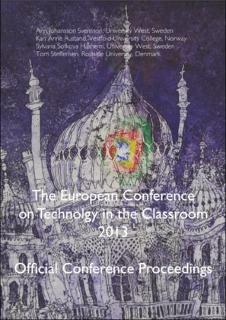| dc.contributor.author | Svensson, Ann Johansson | |
| dc.contributor.author | Rustand, Kari Anne | |
| dc.contributor.author | Hashemi, Sylvana Sofkova | |
| dc.contributor.author | Steffemsem, Tom | |
| dc.date.accessioned | 2022-10-26T08:03:24Z | |
| dc.date.available | 2022-10-26T08:03:24Z | |
| dc.date.created | 2014-03-20T14:35:28Z | |
| dc.date.issued | 2013 | |
| dc.identifier.citation | Svensson, A., Sofkova Hashemi, S., Steffensen, T., & Rustand, K. A. (2013). Students’ Use of Semiotic Structures in Synchronous Computer-Mediated Communication: An Inter-Scandinavian Study. I The European Conference on Technology in the Classroom 2013, ECTC 2013 (s. 150-163). The International Academic Forum (IAFOR). | en_US |
| dc.identifier.issn | 2188-1138 | |
| dc.identifier.uri | https://hdl.handle.net/11250/3028325 | |
| dc.description.abstract | Synchronous computer-mediated communication is often used as a means to achieve active learning through collaboration. This paper is based on an ethnographic case study of synchronous communication. The synchronous communication is carried out between students in lower secondary school collaborating in a cross-border project involving the native language subjects Danish, Norwegian and Swedish. The project is aimed at promoting the students` Scandinavian inter-comprehension skills. The objective is for the students to use their own native languages in their communication whilst trying to understand the neighbouring languages used by their interlocutors. The aim of this paper is to analyse the students` use of situated semiotic structures in order to solve comprehension difficulties as well as emergent technical problems. In the emergent situations where the students face technical or language-based problems they use an interplay of different semiotic structures. They creatively and spontaneously use oral and written communication in different ways by using smileys, colours, gestures, grimaces, talking slowly and by sending smartphone pictures. Furthermore, they make use of different conversational forms such as online chats, Google Translate, and webcams. Synchronous communication is vulnerable because of the dependency relationship arising between the connected classrooms in different schools and countries. The multiple forms of conversation are dependent on the emergent situation and are dominated by the written mode. | en_US |
| dc.language.iso | eng | en_US |
| dc.relation.uri | https://papers.iafor.org/submissionectc2013_0193/ | |
| dc.title | Students’ Use of Semiotic Structures in Synchronous Computer-Mediated Communication : An Inter-Scandinavian Study | en_US |
| dc.title.alternative | Students’ Use of Semiotic Structures in Synchronous Computer-Mediated Communication - An Inter-Scandinavian Study | en_US |
| dc.title.alternative | Students Use of Situated Semiotic Structures in Synchronic Inter-Scandinavian Communication | en_US |
| dc.type | Journal article | en_US |
| dc.description.version | publishedVersion | en_US |
| dc.rights.holder | © The International Academic Forum 2013. [Tilgjengeliggjort med tillatelse] | en_US |
| dc.source.pagenumber | 150-163 | en_US |
| dc.source.journal | The European Conference on Technology in the Classroom : Official Conference Proceedings | en_US |
| dc.identifier.cristin | 1123589 | |
| cristin.ispublished | true | |
| cristin.fulltext | preprint | |
